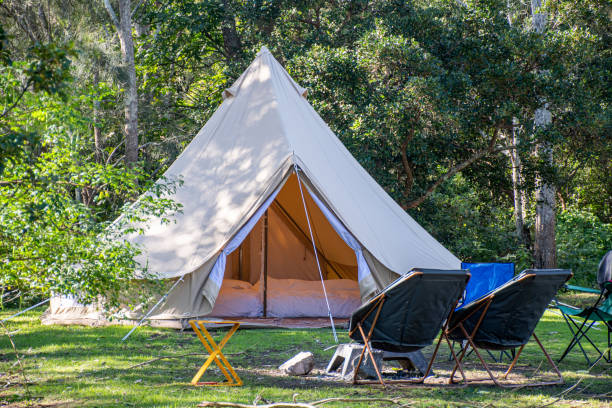When it comes to experiencing the great outdoors, there are two major ways to do it: glamping and traditional camping. Both offer unique opportunities to connect with nature, but each comes with its own set of advantages and challenges. Whether you’re an avid outdoors enthusiast or someone looking for a more comfortable way to enjoy nature, it’s important to understand the differences between these two types of outdoor experiences before you hit the trail. Here’s a breakdown of glamping (glamorous camping) versus traditional camping, along with the pros and cons of each to help you decide which is right for your next adventure.
Traditional Camping
Traditional camping is all about returning to the basics: pitching a tent, building a fire, and truly immersing yourself in nature. Whether you’re sleeping under the stars, cooking over an open fire, or hiking to remote locations, camping offers a rustic and authentic outdoor experience.
Pros of Traditional Camping
- Authentic Connection to Nature: Traditional camping allows you to completely disconnect from the modern world. There are no distractions, so you can fully engage with the natural surroundings—be it a forest, a mountain range, or a quiet lake.
- Cost-Effective: Camping is generally less expensive than glamping. You can camp in national parks, forests, or even in your own backyard with just a tent, a sleeping bag, and basic supplies.
- Simplicity and Freedom: Traditional camping lets you enjoy the simplicity of life. You’ll rely on your skills to set up camp, cook meals, and navigate the outdoors. The freedom of being self-sufficient is a key part of the experience.
- Adventure and Challenge: For many, camping is an adventure. Hiking to remote sites, braving the elements, and facing the challenges of setting up camp can be exciting and rewarding.
Cons of Traditional Camping
- Comforts Are Minimal: Traditional camping can be physically uncomfortable. Sleeping on the ground, limited shelter, and weather unpredictability can make it tough for some, especially if you’re not used to outdoor living.
- Weather-Dependent: If you camp during the wrong season or experience unexpected weather, it can significantly impact your experience. Rain, extreme heat, or cold can make things difficult.
- Limited Amenities: Traditional camping sites often don’t have facilities like bathrooms or electricity, which means you’ll need to bring your own gear (e.g., portable stove, lanterns) and deal with basic necessities like using a public restroom or forgoing a hot shower.
Glamping (Glamorous Camping)
Glamping is a more luxurious way to experience the outdoors without sacrificing comfort. Think of it as a blend between traditional camping and staying in a boutique hotel. Glamping sites typically offer fully furnished tents, yurts, treehouses, or cabins, with comfortable beds, electricity, and even bathrooms.
Pros of Glamping
- Comfort and Convenience: One of the main advantages of glamping is the comfort it offers. You won’t have to sleep on the ground, and you’ll often enjoy luxuries like plush bedding, heating or air conditioning, private bathrooms, and gourmet meals. It’s ideal for those who want the experience of nature without roughing it.
- Less Hassle: Glamping takes away much of the preparation and physical effort that comes with traditional camping. You don’t need to worry about pitching a tent, starting a fire, or cooking over an open flame. Most glamping sites provide ready-made accommodations and offer additional services like housekeeping, meals, and organized activities.
- Unique and Stylish Accommodations: Glamping offers a range of creative and stylish accommodations that are often designed to blend seamlessly with the natural surroundings. Whether it’s staying in a luxury tent with plush bedding or a treehouse with panoramic views, these spaces can provide a chic way to enjoy the outdoors.
- Ideal for Beginners or Families: For people who might be intimidated by traditional camping or who want to enjoy the outdoors with young children, glamping can be a much easier and more comfortable introduction to nature.
Cons of Glamping
- More Expensive: While you may save time and effort, glamping is usually pricier than traditional camping. The luxury amenities, private accommodations, and personalized services come at a cost, which can make it out of reach for some travelers.
- Less of a “Roughing It” Experience: If part of the appeal of camping is the challenge and immersion in nature, glamping may feel a bit too comfortable for some. It can be hard to truly disconnect when you’re surrounded by luxurious amenities.
- Limited Availability: Glamping sites are often located in specific destinations and might not be available in more remote or rugged areas. Availability can also be seasonal, and reservations may need to be made months in advance.
Best Places for Traditional Camping
- Yosemite National Park (California, USA): Known for its stunning landscapes, Yosemite offers numerous camping opportunities in its wilderness. From secluded backcountry sites to campgrounds with amenities, there’s something for everyone.
- Banff National Park (Alberta, Canada): Set in the Canadian Rockies, Banff is a beautiful spot for traditional camping, with plenty of lakes, forests, and mountain trails to explore.
- Kruger National Park (South Africa): For those seeking a truly immersive wilderness experience, Kruger National Park offers rustic camping options, along with safaris to see Africa’s wildlife up close.
Best Places for Glamping
- The Muir Wood Treehouse (California, USA): Stay in a luxurious treehouse in the towering redwoods of Muir Woods National Monument. With stunning views, a comfortable bed, and modern amenities, this is glamping at its finest.
- Under Canvas (Various Locations, USA): With locations near national parks like Yellowstone and Zion, Under Canvas offers luxurious tents with king-sized beds, private bathrooms, and gourmet dining, allowing you to experience nature without sacrificing comfort.
- Glen Eden Resort (New Zealand): For a more remote but luxurious experience, Glen Eden Resort offers stunning glamping tents that provide comfort in the heart of nature, set amid New Zealand’s breathtaking scenery.
Which Is Right for You?
- Go for Traditional Camping if:
- You want a more immersive, hands-on outdoor experience.
- You enjoy the adventure and challenge of setting up camp and living simply in the wild.
- You’re looking for a budget-friendly way to enjoy nature.
- You love the idea of being completely disconnected from technology and everyday comforts.
- Go for Glamping if:
- You want to experience nature but aren’t keen on roughing it.
- You enjoy luxury amenities and a more comfortable environment while still being in beautiful surroundings.
- You’re a first-time camper or traveling with family or friends who might not be familiar with traditional camping.
- You have a higher budget and want an easy, stress-free way to enjoy the outdoors.
Ultimately, both glamping and traditional camping offer unique ways to enjoy the outdoors, but your choice will depend on what you’re looking for in your adventure. If you’re a true nature lover who values the simplicity and authenticity of the wilderness, traditional camping will provide the ultimate experience. On the other hand, if you’re seeking comfort, convenience, and a bit of luxury while still connecting with nature, glamping might be the perfect fit for you. Whatever your choice, both options offer a chance to unwind, relax, and enjoy the beauty of the natural world in your own way.

